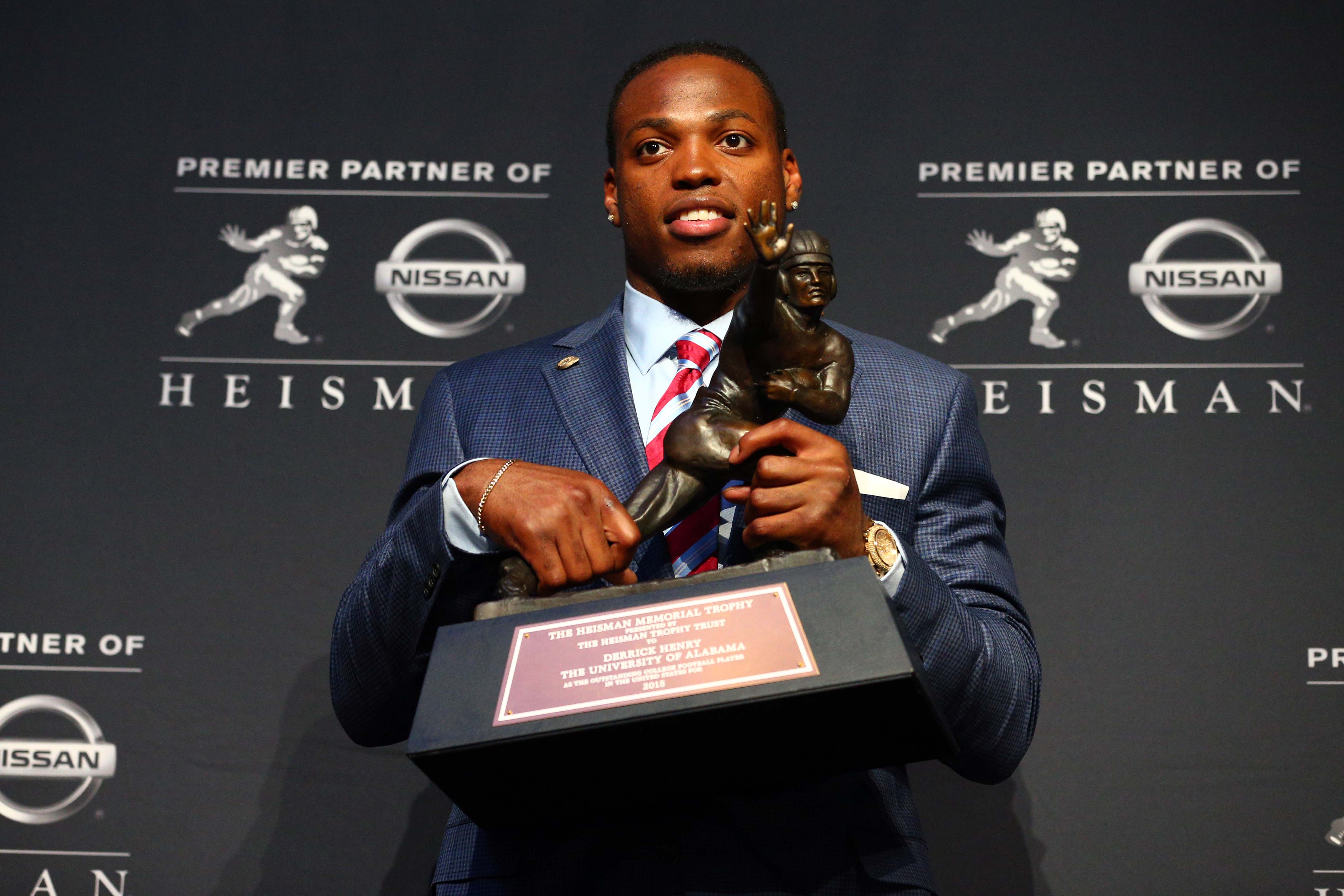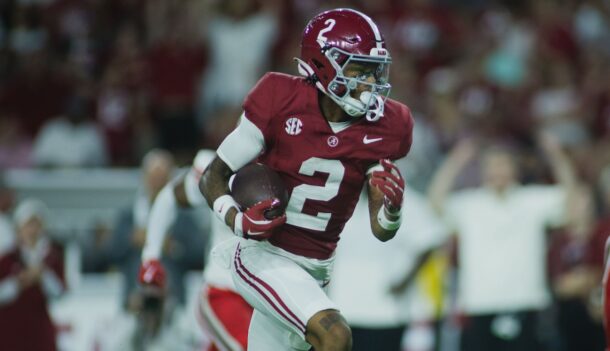
Why great players on merely good teams can’t win the Heisman Trophy
By Joe Cox
Published:
Dak Prescott was one of the best players in the nation in 2015. And it was a poorly kept secret.
No less of an authority than Sports Illustrated put Prescott on the cover of their college football preview, touting him as a Heisman candidate. And Prescott delivered — almost 4,000 yards passing, 29 touchdowns to five interceptions, and another 10 scores on the ground. But his Heisman campaign went nowhere, because Prescott’s Bulldogs went a solid, if not stupefying, 9-4.
Never mind the fact that only twice in the past 75 years had the Bulldogs won more than nine games. It wasn’t enough for the Heisman voters — as Prescott failed to make the top 10 in the final Heisman standings.

So who can win? Generally a star offensive player at a glamour position for a top 10 team, preferably one in the national championship hunt, like the past three winners: Alabama’s Derrick Henry, Oregon’s Marcus Mariota and Florida State’s Jameis Winston.
But how did it get this way? In essence, why can’t great players on good teams — or even on not so good teams — win the Heisman Trophy? The answer lies in history.
1956 vote changed dynamic
Sixty years ago, the most controversial Heisman trophy voting ever was conducted. Take the star senior quarterback off of SEC champion Tennessee, which was 10-0 and second in the nation. We’ll call him Johnny Majors. Take the stud senior running back from top-ranked Oklahoma (also 10-0), Tommy McClendon. If you wanted an upset candidate, take the superstar senior running back from 8th-ranked Syracuse, a star who vaulted the relatively unknown Orangemen into a bid in the Cotton Bowl. And just for good measure, he happened to be the greatest running back of his era and perhaps any other, Jim Brown.
But none of those guys won.
McDonald got the most first-place votes. Majors got the most second-place votes. Brown finished fifth.
The winner of the 1956 Heisman trophy was a quarterback who threw three touchdowns and 13 interceptions (for comparison’s sake, Majors, in a run-heavy offense, threw five touchdowns and three interceptions). Notre Dame’s Paul Hornung was undoubtedly one of the best players in the nation. His Irish entered that season ranked No. 3. But he led a 2-8 Notre Dame team to absolutely nothing in 1956. When Hornung’s team faced McClendon’s Oklahoma squad, Oklahoma won. By 40. The Irish also lost to Michigan State by 33, and to Iowa by 40. But the voters, in a very close race, chose Hornung.
The Heisman race changed that day because everything about the 1956 vote feels wrong today.
Star veteran players off the top two teams were passed by. And not for Brown, whose team was also very good and who, with all respect to Majors and McClendon, was ultimately the best player of the bunch. All of this star power was passed over for a great player on a losing team. It’s never happened.
Once, in 1969, Oklahoma running back Steve Owens won the Heisman from a 6-4 squad that did not make a bowl game. But Owens was superb, with over 1,500 rushing yards and 23 touchdowns. And his closest competitor, Purdue quarterback Mike Phipps, led the Boilermakers to just 18th in the final AP poll. Archie Manning finished fourth after leading the Rebels to an 8-3 season. There was no evident miscarriage of justice.
Now, Heisman winners typically on top 10 teams
Throughout the 1980s, star players off teams that were unranked or in the lower half of the AP poll commonly won the Heisman Trophy. A lifetime achievement type mentality meant that Bo Jackson won the 1985 Heisman for an Auburn team that went unranked in the last AP poll. Or Tim Brown won for a No. 17-ranked Notre Dame squad in 1987. As the 1980s turned into the 1990s, statistical heroes like Houston quarterback Andre Ware or BYU passer Ty Detmer won the Heisman — both playing for good, but not great teams.
But no more. In the 25 years since Detmer won the Heisman, only three times has the winner come from a team that did not end the season within the AP top 10. And in all three instances, the award was a sort of accumulated achievement for players whose teams barely were outside the top 10 — for Ricky Williams (of No. 15 Texas in 1998), for Tim Tebow (of No. 13 Florida in 2007), and for Robert Griffin III (of No. 13 Baylor in 2011). There remains a tiny window for great players from very good, but not great, teams. But only a tiny window.

The most interesting Heisman candidacy, and the one that seems to dictate forever that no great player from a bad team can win was that of Steve McNair in 1994. In a very down Heisman field, McNair was by far the most dominant option, leading FCS (then I-AA) Alcorn State to a solid 8-3-1 campaign by shattering pretty much every offensive record in the history of football.
But even if McNair was the best player in college football (and Heisman winner Rashaan Salaam would probably have to admit that McNair was), would Heisman voters pick a player whose team lost to Sam Houston State, or dropped a playoff game to Youngstown State by 43? No, they wouldn’t. McNair finished a distant third, and seemingly forever settled the point that great players on bad teams don’t win Heisman trophies.
Many modern stars running uphill toward Heisman
So what changed, between Hornung’s era and modern times?
Many things, but for Heisman purposes, freshman eligibility, the additional of conference championship games and an increasingly sophisticated championship system are the three biggest factors. In 1956, the Heisman unofficially was an award for seniors. Freshmen didn’t play, and none but perhaps the very best junior need apply.
In the era of Johnny Manziel and Cam Newton, one-and-done might be enough to win the Heisman Trophy. And if the Heisman transforms from a career achievement to a single-season award, then only the best players on the best teams for that season will be considered. Voters don’t care if Prescott was great on some very good Mississippi State teams for four years. They care about who led the SEC’s top team in 2015.
As to the conference and BCS title changes, back in 1956, it was still very much unclear whether Team X was actually considered better than Team Y. Nowadays, we are all obsessed with whether Team X is better than Team Y. There are rankings upon rankings upon point systems upon analytical models.
And with team success being so clearly defined and pivotal, the starting point for the Heisman has become not who is the best player, but who is the best player on the best team or teams.
Proponents of a broadened playoff need to be aware that such a change will probably further restrict the Heisman race. It would be a rare situation in which voters would feel safe to reach outside the championship qualifying eight (or however many ) teams. Even if Navy QB Keenan Reynolds typifies everything right about college football, the Midshipmen weren’t playing in the national title semifinals — and that definitely mattered.

As the college football hot stove league simmers, lots of names will be thrown around for college football’s top prize in 2016. But the odds say, stick to the best offensive players on the top handful of teams.
Leonard Fournette can be better than, say, Alabama running back Bo Scarbrough or Damien Harris. But can LSU beat Alabama? If not, Fournette is running uphill in the Heisman vote. Likewise for Georgia stud Nick Chubb.
Clemson’s Deshaun Watson finished third last year and lost to Alabama in the championship game. His 2016 Heisman bid likely will be determined by whether he can get past Florida State and its candidate, Dalvin Cook.
Whomever ends up at quarterback for Ohio State probably has a better chance than stars on lesser teams — not on the merits of on-field play, but just under the unwritten current Heisman rules.
Until something crazy like 1956 happens again, that is where we stand.
Joe Cox is a columnist for Saturday Down South. He has also written or assisted in writing five books, and his most recent, Almost Perfect (a study of baseball pitchers’ near-miss attempts at perfect games), is available on Amazon or at many local bookstores.







